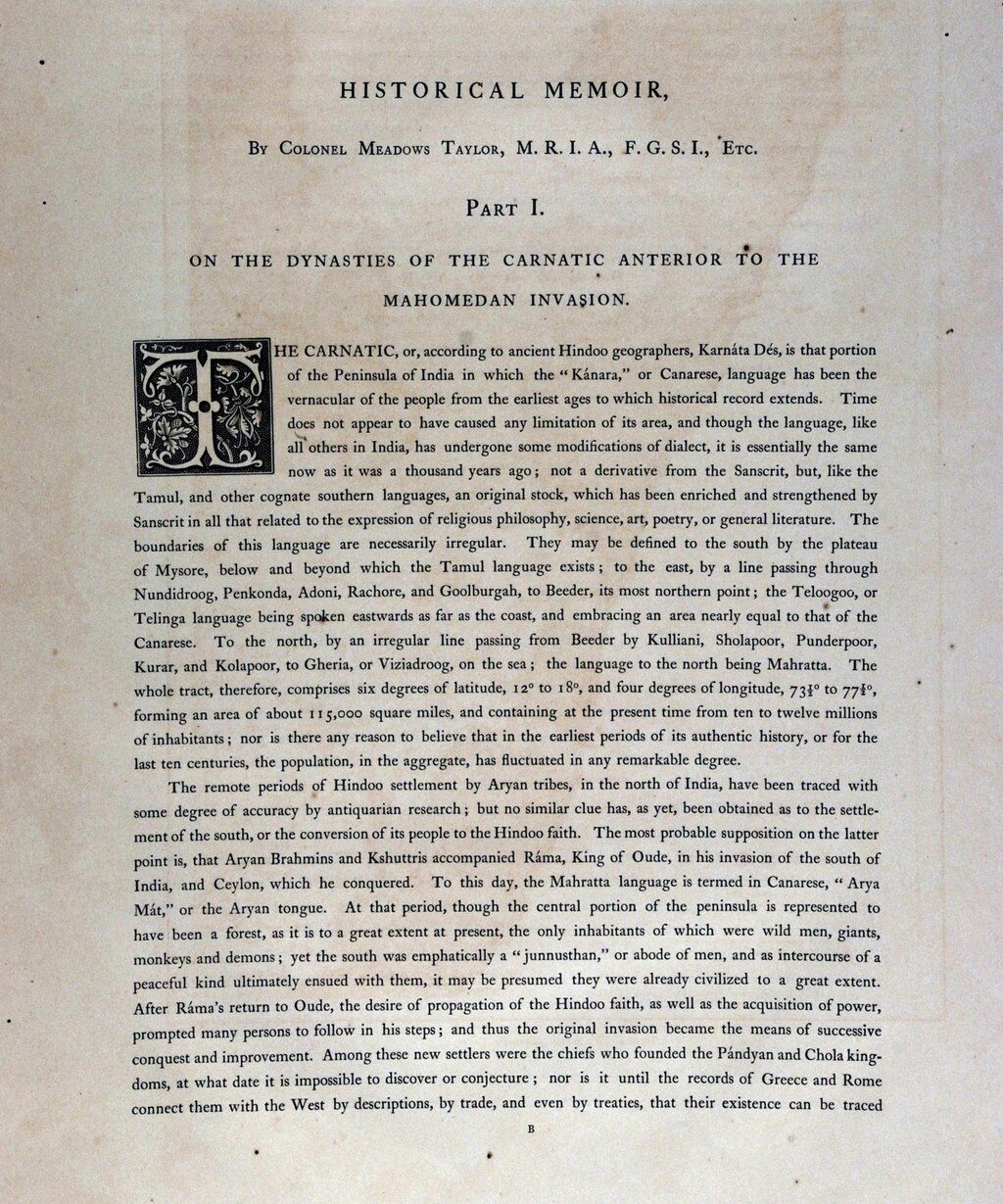HISTORICAL MEMOIR,
By Colonel Meadows Taylor, M. R. I. A., F. G. S. I., Etc.
Part I.
ON THE DYNASTIES OF THE CARNATIC ANTERIOR TO THE MAHOMEDAN INVASION.
THE CARNATIC, or, according to ancient Hindoo geographers, Karnata Des, is that portion of the Peninsula of India in which the “ Kanara,” or Canarese, language has been the vernacular of the people from the earliest ages to which historical record extends. Time does not appear to have caused any limitation of its area, and though the language, like all others in India, has undergone some modifications of dialect, it is essentially the same now as it was a thousand years ago; not a derivative from the Sanscrit, but, like the Tamul, and other cognate southern languages, an original stock, which has been enriched and strengthened by Sanscrit in all that related to the expression of religious philosophy, science, art, poetry, or general literature. The boundaries of this language are necessarily irregular. They may be defined to the south by the plateau of Mysore, below and beyond which the Tamul language exists ; to the east, by a line passing through Nundidroog, Penkonda, Adoni, Rachore, and Goolburgah, to Beeder, its most northern point; the Teloogoo, or Telinga language being spoken eastwards as far as the coast, and embracing an area nearly equal to that of the Canarese. To the north, by an irregular line passing from Beeder by Kulliani, Sholapoor, Punderpoor, Kurar, and Kolapoor, to Gheria, or Viziadroog, on the sea; the language to the north being Mahratta. The whole tract, therefore, comprises six degrees of latitude, 120 to i8°, and four degrees of longitude, 73I0 to yyi°. forming an area of about 115,000 square miles, and containing at the present time from ten to twelve millions of inhabitants; nor is there any reason to believe that in the earliest periods of its authentic history, or for the last ten centuries, the population, in the aggregate, has fluctuated in any remarkable degree.
The remote periods of Hindoo settlement by Aryan tribes, in the north of India, have been traced with some degree of accuracy by antiquarian research; but no similar clue has, as yet, been obtained as to the settlement of the south, or the conversion of its people to the Hindoo faith. The most probable supposition on the latter point is, that Aryan Brahmins and Kshuttris accompanied Rama, King of Oude, in his invasion of the south of India, and Ceylon, which he conquered.
To this day, the Mahratta language is termed in Canarese, “ Arya Mat,” or the Aryan tongue, At that period, though the central portion of the peninsula is represented to have been a forest, as it is to a great extent at present, the only inhabitants of which were wild men, giants, monkeys and demons; yet the south was emphatically a junnusthan,” or abode of men, and as intercourse of a peaceful kind ultimately ensued with them, it may be presumed they were already civilized to a great extent. After Rama’s return to Oude, the desire of propagation of the Hindoo faith, as well as the acquisition of power, prompted many persons to follow in his steps; and thus the original invasion became the means of successive conquest and improvement. Among these new settlers were the chiefs who founded the Pandyan and Chola kingdoms, at what date it is impossible to discover or conjecture ; nor is it until the records of Greece and Rome connect them with the West by descriptions, by trade, and even by treaties, that their existence can be traced
